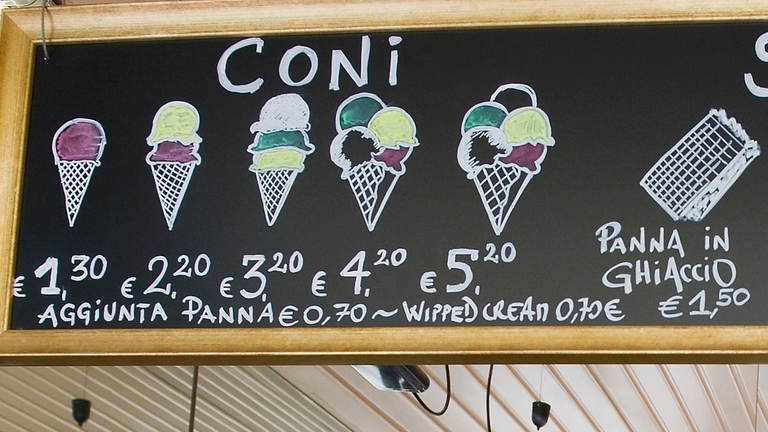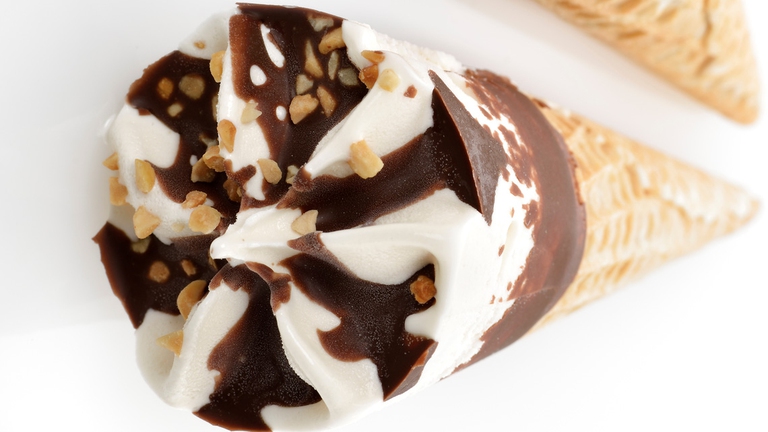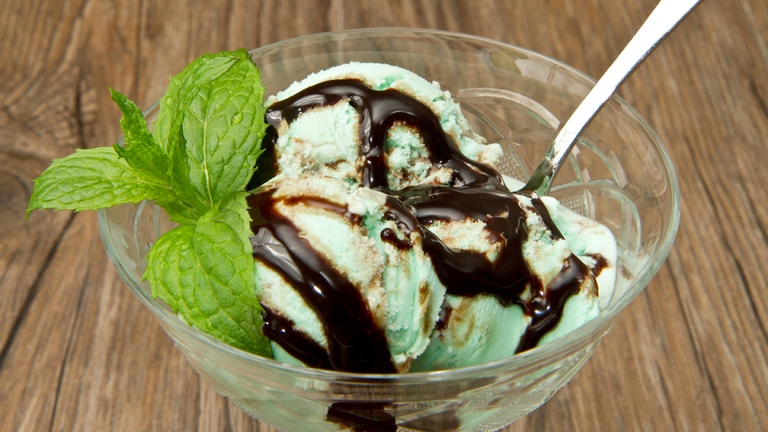https://www.lifegate.it/gelato
- |
First published: January 7, 2010
Ice cream in the diet
From a point of view of ingredients, ice cream can be divided into three different categories:with milk cream, with vegetable fats and with fruit.The milk cream ones are four times fatter than the fruit ones, preferable for those who want to stay fit in the summer.But milk cream ice creams contain a good thirty percent more protein.The energy and nutritional intake of a milk ice cream can easily replace a snack because it does not weigh down the body and helps provide energy to effectively resume study or work activities.
Ice creams with vegetable fats, used to replace milk, have a different presence of fat-soluble vitamins.
Fruit pulp, sugar and water for fruit ice creams which, especially if used fresh, provides a good dose of vitamin C.The protein content depends on the quantity of milk used, the presence or absence of egg and some biscuit or wafer.

The beneficial effects of ice cream
With all types of ice cream, proteins, sugars and fats are introduced into the body along with a good dose of phosphorus and calcium.Ice cream performs a useful action on a digestive level because it stimulates the emptying of the stomach (reduces the working time of gastric juices) and promotes bile secretion to the benefit of fat digestion.The important thing is to ingest the ice cream immediately after the meal or away from it, its low temperature may not favor the digestive process.
What are the contraindications of ice cream
 Ice cream has no contraindications for those in good health.© Ingimage
Ice cream has no contraindications for those in good health.© Ingimage
For those suffering from gastritis or ulcers, ice cream must melt in the mouth.Another matter for those who can't tolerate milk or throw themselves headlong into tubs or giant ice cream cones... watch out for abuse:like any other food, the same rule applies to ice cream.
The types of ice cream

Industrial or artisanal ice cream?Organic or conventional?Cream or fruit?It is essential to look for a healthy and natural product, free of unwanted fats and colourants.
1.Homemade ice cream
[caption id="attachment_108162" align="alignnone" width="1140"] Homemade ice cream is subject to various rules.© Ingimage
Homemade ice cream is subject to various rules.© Ingimage
To produce it, each ice cream maker must comply with a "Regulation on artisanal ice cream" which guarantees the use of fresh ingredients and healthy production techniques"Artisanal ice cream is a food preparation brought to a solid and pasty state by mixing and freezing the mixture of ingredients" states the Specifications.
During freezing, by stirring the mixture, air is incorporated which gives softness and creaminess to the ice cream.Which, in order to boast the name "artisan", must be characterized by the prevalent use of fresh raw materials:the other ingredients can then be chosen directly by the craftsman according to his creativity.Homemade ice cream must be sold within a few days of its production.
Read also: How to read the ice cream label
The ingredients of artisanal ice cream
Characterizing ingredients (they can be fresh, or frozen, or already in puree or paste):milk, cream;egg;fruit. Semi-finished products:“In the preparation of milk ice creams, the use of semi-finished products (i.e. those preparations intended exclusively for the production of ice cream, but not for direct consumption) is possible, provided that they represent a maximum of 10% by weight of the recipe” states the Specifications.
Additives:(from the Specifications): "The use of additives legally permitted by the provisions in force is permitted with the exclusion of artificial colors and flavourings.Even semi-finished products cannot contain artificial colourings, artificial flavourings, synthetic or otherwise so-called artificial sweeteners".
2.Industrial ice cream

The first difference with artisanal ice cream concerns freshness:in fact, this product is prepared many months before consumption.The ingredients generally include powdered milk, sugar, vegetable oils, hydrogenated vegetable fats, colourants, emulsifiers, stabilizers and flavourings.
Industrial ice creams are produced with a massive introduction of air (min 70%) during the freezing phase, which makes them particularly soft.
Read also:What's inside the ice cream:what are the ingredients of ice cream
The ingredients of industrial ice cream
Used as amalgamants and emulsifiers, hydrogenated or partially hydrogenated vegetable fats are among the most common ingredients in the products we find in the supermarket (snacks, industrial pastries, stock cubes, ready-made fried foods).In ice cream they are used as stabilizers and emulsifiers.
Flavors:if it only says "flavors" they are certainly artificial.They are ubiquitous in tub ice cream.
Hydrogenated (or partially hydrogenated) vegetable fats:they are industrial compounds very common in ice cream.They have the particularity of slowly going rancid and therefore prolonging the commercial life of the product.They also cost less than natural fats like butter and have a higher melting point.Hydrogenated fats have negative implications for health.In fact, they contain the feared "trans" fats, believed to be responsible for raising "bad" cholesterol levels and increasing blood density, aggravating the risk of cardiovascular problems.For this reason it is important to read the labels carefully, keeping in mind that their use in organic ice cream is prohibited by law.
Dyes:the presence of dyes is indicated on the label.European legislation requires that they appear under the initials E followed by a number between 100 and 200.Ice cream can be excellent even without containing them, in fact colorants do not have a flavor or nutritional value, but only serve to make our ice cream more pleasing to the eye.We choose ice cream shops that don't use them (or at least that use them natural dyes):we will discover what the true color of our favorite flavor is, and we will gain in naturalness.
3.Organic ice cream

Prepared with ingredients from organic farming, organic ice cream is not only tasty and healthy but is also a clear example of how the quality of the raw materials can influence the final product.The milk used is in most cases fresh whole milk, the sugar is whole cane, fresh cream, eggs, fruit, honey, yogurt, all obtained without the use of pesticides.Additives and flavors are never artificial, colorings are prohibited, as are GMOs, guaranteeing everything through organic certification bodies.
Beyond these already consolidated practices, a growing trend emerges that favors the production of ice cream with free-from options', where the absence of added sugars, lactose, artificial colors and flavors meets the growing demand of health-conscious consumers.These options not only continue to promote a sustainable approach to food production, but also respond to the desire to indulge responsibly, with products that respect both human health and the environment.The innovations include the offer of vegan and plant-based variants, which use alternatives to milk such as almond, soy, or oat, strengthening the commitment to a more inclusive ice cream production that is attentive to different dietary needs.
Ice cream consumption in Italy and European regulations
In Italy, the per capita consumption of ice cream is about 8 liters per year, demonstrating a constant predilection for this dessert.This data helps us to better understand the importance of ice cream in the Italian diet and underlines the need for high quality products.
At the same time, European regulations play a crucial role in ensuring this quality.For example, German laws require that ice cream made from milk must contain at least 70% real milk, and cream ice creams must have at least 10% milk fat and 270 grams of eggs per liter.These standards ensure that the end consumer receives a product that is not only tasty but also nutritionally valid.
Ice cream FAQs
- What are the main ingredients of artisanal ice cream? The main ingredients of artisanal ice cream include milk, cream, sugar and, depending on the taste, eggs and natural flavors such as fruit, chocolate, vanilla and hazelnuts can be added.
- How is artisanal ice cream produced? The production of artisanal ice cream begins with the selection of high quality ingredients.These are mixed and pasteurized at around 85°C.After rapid cooling of the mixture, freezing follows, a process that introduces air and ensures a soft and creamy consistency.
- How many times a week is it advisable to eat ice cream? Ice cream can be consumed 2-3 times a week, preferably homemade and fruit-flavoured.
- What is Italians' favorite ice cream flavor? In Italy, the most popular ice cream flavors include cream, chocolate and hazelnut, which are considered classics loved for generations.
- Which European country consumes the most ice cream? The European country that consumes the most ice cream is Finland, with an estimated per capita consumption of 14.2 liters per year.Although Finland is known for its cold climate, ice cream consumption occurs mainly during the short summer periods.
